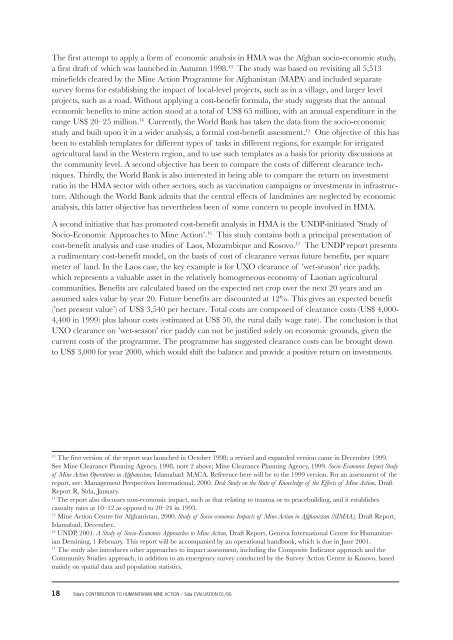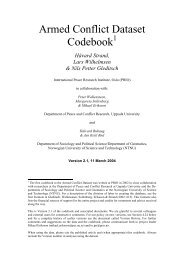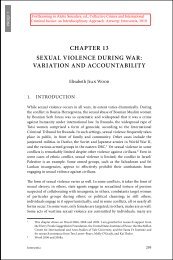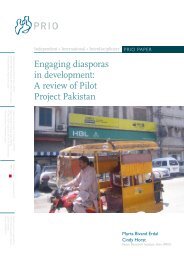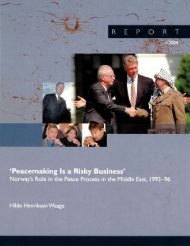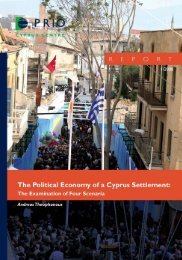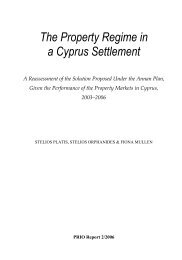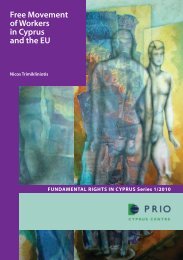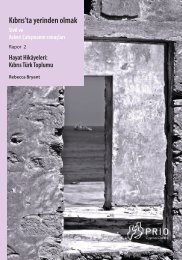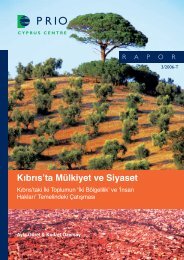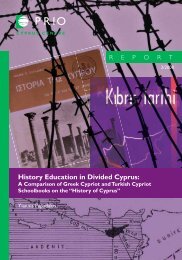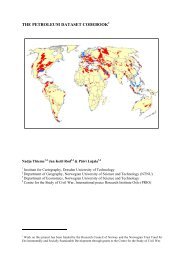The first attempt <strong>to</strong> apply a form of economic analysis in HMA was the Afghan socio-economic study,a first draft of which was launched in Autumn 1998. 13 The study was based on revisiting all 5,513minefields cleared by the <strong>Mine</strong> <strong>Action</strong> Programme for Afghanistan (MAPA) and included separatesurvey forms for establishing the impact of local-level projects, such as in a village, and larger levelprojects, such as a road. Without applying a cost-benefit formula, the study suggests that the annualeconomic benefits <strong>to</strong> mine action s<strong>to</strong>od at a <strong>to</strong>tal of US$ 65 million, with an annual expenditure in therange US$ 20–25 million. 14 Currently, the World Bank has taken the data from the socio-economicstudy and built upon it in a wider analysis, a formal cost-benefit assessment. 15 One objective of this hasbeen <strong>to</strong> establish templates for different types of tasks in different regions, for example for irrigatedagricultural land in the Western region, and <strong>to</strong> use such templates as a basis for priority discussions atthe community level. A second objective has been <strong>to</strong> compare the costs of different clearance techniques.Thirdly, the World Bank is also interested in being able <strong>to</strong> compare the return on investmentratio in the HMA sec<strong>to</strong>r with other sec<strong>to</strong>rs, such as vaccination campaigns or investments in infrastructure.Although the World Bank admits that the central effects of landmines are neglected by economicanalysis, this latter objective has nevertheless been of some concern <strong>to</strong> people involved in HMA.A second initiative that has promoted cost-benefit analysis in HMA is the UNDP-initiated ’Study ofSocio-Economic Approaches <strong>to</strong> <strong>Mine</strong> <strong>Action</strong>’. 16 This study contains both a principal presentation ofcost-benefit analysis and case studies of Laos, Mozambique and Kosovo. 17 The UNDP report presentsa rudimentary cost-benefit model, on the basis of cost of clearance versus future benefits, per squaremeter of land. In the Laos case, the key example is for UXO clearance of ’wet-season’ rice paddy,which represents a valuable asset in the relatively homogeneous economy of Laotian agriculturalcommunities. Benefits are calculated based on the expected net crop over the next 20 years and anassumed sales value by year 20. Future benefits are discounted at 12%. This gives an expected benefit(’net present value’) of US$ 3,540 per hectare. Total costs are composed of clearance costs (US$ 4,000-4,400 in 1999) plus labour costs (estimated at US$ 50, the rural daily wage rate). The conclusion is thatUXO clearance on ’wet-season’ rice paddy can not be justified solely on economic grounds, given thecurrent costs of the programme. The programme has suggested clearance costs can be brought down<strong>to</strong> US$ 3,000 for year 2000, which would shift the balance and provide a positive return on investments.13The first version of the report was launched in Oc<strong>to</strong>ber 1998; a revised and expanded version came in December 1999.See <strong>Mine</strong> Clearance Planning Agency, 1998, note 2 above; <strong>Mine</strong> Clearance Planning Agency, 1999. Socio-Economic Impact Studyof <strong>Mine</strong> <strong>Action</strong> Operations in Afghanistan, Islamabad: MACA. Reference here will be <strong>to</strong> the 1999 version. For an assessment of thereport, see: Management Perspectives International, 2000. Desk Study on the State of Knowledge of the Effects of <strong>Mine</strong> <strong>Action</strong>, DraftReport R, Sida, January.14The report also discusses non-economic impact, such as that relating <strong>to</strong> trauma or <strong>to</strong> peacebuilding, and it establishescasualty rates at 10–12 as opposed <strong>to</strong> 20–24 in 1993.15<strong>Mine</strong> <strong>Action</strong> Centre for Afghanistan, 2000. Study of Socio-economic Impacts of <strong>Mine</strong> <strong>Action</strong> in Afghanistan (SIMAA), Draft Report,Islamabad, December..16UNDP, 2001. A Study of Socio-Economic Approaches <strong>to</strong> <strong>Mine</strong> <strong>Action</strong>, Draft Report, Geneva International Centre for <strong>Humanitarian</strong>Demining, 1 February. This report will be accompanied by an operational handbook, which is due in June 2001.17The study also introduces other approaches <strong>to</strong> impact assessment, including the Composite Indica<strong>to</strong>r approach and theCommunity Studies approach, in addition <strong>to</strong> an emergency survey conducted by the Survey <strong>Action</strong> Centre in Kosovo, basedmainly on spatial data and population statistics.18 Sida’s CONTRIBUTION TO HUMANITARIAN MINE ACTION – Sida EVALUATION 01/06
Cost-benefit analysis underlines the importance of ensuring that cleared land is taken in<strong>to</strong> use immediately.To shorten the time period between clearance and productive use, building confidence amongst future users isessential. Building confidence depends on the investment in good relationships with locals, including forums formutual exchange of information. Studies from Mozambique demonstrate that lack of confidence in clearanceis a problem, and that it can take years before cleared land is taken in<strong>to</strong> use. Given that land is often widelyaccessible in Mozambique, people tend <strong>to</strong> have developed alternative fields for cultivation by the time deminingis conducted, which exacerbates the effects of a lack of confidence.In a different example from Afghanistan, it was found that the locals in a village were unwilling <strong>to</strong> cultivate aparticular area. It proved that a missed anti-tank mine had been found by a local farmer while tilling the land. Ateam from MACA investigated the incident, but no information regarding the results of the investigation was given<strong>to</strong> the community. The lack of post-investigation information further contributed <strong>to</strong> a low confidence level both atthe village level and in surrounding areas.Illustration 2.2: The importance of confidence in clearance 18In the Mozambique case, where the economy is arguably much more varied, applying cost-benefitanalysis is more complicated. Different cost-benefit templates have <strong>to</strong> be tailored <strong>to</strong> each particularproduction system, and the risk of misrepresenting the local particularities increases. The UNDPeconomic analysis from Mozambique draws on data from a household economic study in Nampulaprovince. The same formula as in the Laotian case is applied. Clearance costs are higher, estimated atUS$ 7,000 per hectare. The net present value is calculated for three different production practices:high input at US$ 2,700, improved practices at US$ 1,950, and traditional at US$ 1,247. Hence, mineclearance of agricultural land can not be justified solely on economic grounds, unless clearance costsare dramatically reduced. An alternative example finds very positive returns from clearance of access<strong>to</strong> a village water point, which frees up a scarce resource: women’s time for other activities includingagriculture. In Mozambique, land in itself is rarely a scarce resource, which is one reason that agriculturalproduction scores badly in a cost-benefit analysis.At a general level, the value of economic analysis for securing participation appears limited, in spitethe World Bank’s ambition <strong>to</strong> make it a focus for community-level discussion. The strength of economicanalysis seems <strong>to</strong> be in assessing a programme or a nationwide effort, rather than as a <strong>to</strong>ol for safeguardingimpact at a local level. In terms of phases of projects, economic analysis seems best suited <strong>to</strong>pre- and post- project assessments. A principal strength of economic analysis is its treatment of constraintsand costs. These enter directly in<strong>to</strong> the calculus, and the results visualize gains stemming froma reduction of costs and from working flexibly with constraints. Economic analysis has a role <strong>to</strong> play inany stage from emergency <strong>to</strong> development. Nonetheless, given its narrow focus on economic impact,economic analysis should not be seen as the dominant approach <strong>to</strong> impact assessment in HMA, but asa useful complement <strong>to</strong> other approaches.Composite indica<strong>to</strong>rCurrently, the most influential approach <strong>to</strong> impact assessment in HMA is the global Level One ImpactSurvey (LOIS) run by the Survey <strong>Action</strong> Centre (SAC). 19 The LOIS is emerging as the international18Information gathered during Harpviken's fieldwork in Afghanistan, spring 1999. The example is not meant <strong>to</strong> indicate thatmissed mines are more frequent in the Afghan programme than elsewhere. In fact, the Afghan programme is exemplary inreporting transparently on demining accidents as well as missed mines. See Millard & Harpviken, 2000, see note 6 above.19SAC is a consortium of NGOs and UN agencies, managed by the Vietnam Veterans of America Foundation (VVAF). It iscurrently engaged in thirteen countries, with actual implementation of a survey being under way in five of those: Cambodia,Chad, Kosovo, Mozambique and Thailand. In Yemen, a survey was completed in late 2000 For background on SAC, see thewebpages at http://www.vvaf.org/gls/index.shtmlSida’s CONTRIBUTION TO HUMANITARIAN MINE ACTION – Sida EVALUATION 01/06 19
- Page 4: This report is part of Sida Evaluat
- Page 9 and 10: MDDMEDDSMGMMLSWMoPHMOUMPLANATONDING
- Page 12 and 13: the conclusions of this report is t
- Page 14 and 15: A prime concern with Mine Action Ce
- Page 16 and 17: 3. The coordination of mine action,
- Page 18 and 19: an needs and the needs of victims o
- Page 20 and 21: At the same time as Sida has been o
- Page 22 and 23: er, throughout the data collection,
- Page 24 and 25: Donors may feel that the costs of i
- Page 26 and 27: is genuinely new. 8 At an overall l
- Page 30 and 31: standard for basic impact surveys.
- Page 32 and 33: Community studiesCommunity studies
- Page 34 and 35: and progress monitored in all phase
- Page 36 and 37: 3 Implementation ChannelsOver the p
- Page 38 and 39: cal implementation and management,
- Page 40 and 41: ing that demining has any effect at
- Page 42 and 43: actual response. In an effort to ov
- Page 44 and 45: ecently developed. The approaches t
- Page 46 and 47: A different tool that will be used
- Page 48 and 49: Alternative implementation channels
- Page 50 and 51: appear to have been doing a good jo
- Page 52 and 53: Coordination may at times even be c
- Page 54 and 55: itarian and development effort. Imp
- Page 56 and 57: Two). In terms of coordinating mine
- Page 58 and 59: ased demining of AREA. Another type
- Page 60 and 61: The Kosovo UNMACC took a number of
- Page 62 and 63: would be accredited and tasked by U
- Page 64 and 65: programme. The proposal was backed
- Page 66 and 67: The present landscape of Swedish ac
- Page 68 and 69: demining purposes. Buoyed by a wave
- Page 70 and 71: given that SRSA also recruits perso
- Page 72 and 73: teams. The need for a breeding capa
- Page 74 and 75: 6 RecommendationsIn the preceding c
- Page 76 and 77: • MACs should operate with agreem
- Page 78 and 79:
7 ConclusionIn this report, we have
- Page 80:
70Appendix 1
- Page 89 and 90:
Ziauddin Operations Officer METADup
- Page 91 and 92:
Bennedich, Claes Department for eva
- Page 93 and 94:
Appendix 3BIBLIOGRAPHYAccelerated D
- Page 95 and 96:
Faulkner, F. & L Pettiford, 1998.
- Page 97 and 98:
McGrath, Rae, 2000. Landmines and U
- Page 99 and 100:
Miscellaneous DocumentsBrady, Justi
- Page 101 and 102:
Appendix 4Sida’s CONTRIBUTION TO
- Page 103 and 104:
Appendix 6• The area must be secu
- Page 105 and 106:
Appendix 7Locality identifier: Dist
- Page 107:
Recent Sida Evaluations00/37:1 Asse


